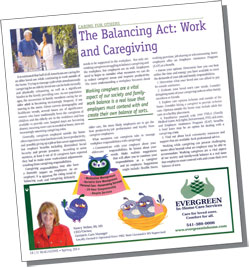By Nancy Webre, BS, MS
 It is estimated that half of all Americans are caring for an older loved one while continuing to work outside of the home. Trying to manage a job while simultaneously caregiving for an elderly loved one can be both mentally and physically exhausting, as well as a significant burden to the family providing care. As our population ages, the occurrence of family members caring for an older adult is becoming increasingly frequent, if not moving to the norm. Given current demographic and healthcare trends, several issues are of significance: women who have traditionally been the caregivers of children and the elderly are in the workforce and less available to provide care; hospital stays are becoming shorter, meaning more care is needed at home; men are increasingly assuming caregiving roles.
It is estimated that half of all Americans are caring for an older loved one while continuing to work outside of the home. Trying to manage a job while simultaneously caregiving for an elderly loved one can be both mentally and physically exhausting, as well as a significant burden to the family providing care. As our population ages, the occurrence of family members caring for an older adult is becoming increasingly frequent, if not moving to the norm. Given current demographic and healthcare trends, several issues are of significance: women who have traditionally been the caregivers of children and the elderly are in the workforce and less available to provide care; hospital stays are becoming shorter, meaning more care is needed at home; men are increasingly assuming caregiving roles.
Generally, caregivers employed outside the home often experience time lost from work, lower productivity, and possibly giving up a job or lost career opportunities, lost employer benefits including diminished Social Security and private pensions. According to some statistics, at least 6 out of 10 caregivers have reported they had to make some work-related adjustments resulting from caregiving responsibilities.
Caregiving responsibilities may also have a dramatic impact on employers. As an employer, it is apparent the rising trend of balancing work and caregiving definitely needs to be supported in the workplace. Not only are working caregivers struggling to balance caregiving and the workplace, but employers are as well. Employers need to begin to consider what measures we can do to reduce caregiver stress and improve productivity. The more understanding a workplace becomes about elder care, the more likely employers are to get the best productivity/job performance and loyalty from caregiver employees.
What measures can caregivers take to manage workplace responsibilities with caregiving?
- Communicate with your employer about your eldercare responsibilities. Be honest about your needs. Make realistic suggestions that will allow you to continue your responsibilities as a caregiver and an employee. Suggestions might include: flexible hours, working part-time, job sharing or telecommuting. Some employers offer an Employee Assistance Program (EAP) as a benefit.
- Assess your options. Determine how you can best utilize the time and energy you have available to meet the demands of your job and family responsibilities.
- Determine what your loved one can afford to pay for outside assistance.
- Evaluate your loved one’s care needs. Consider delegating some of your caregiving tasks to other family members or friends.
- Explore care options in-home and outside of the home. Consider hiring a caregiver to provide in-home care. Options outside the home may include adult day care or a facility placement.
- Familiarize yourself with your FMLA (Family Medical Leave Act) rights, bereavement, PTO, sick time, and Employee Assistance Program (EAP) benefits. A brief leave may be an option for dealing with a caregiving crisis.
- Find out about local community resources and support that are available. Seek professional advice.
Working while caregiving can present challenging issues often beyond what an employer may be able to accommodate. Working caregivers are a vital aspect of our society and family-work balance is a real issue that employers must contend with and create their own balance of sorts.
As seen in U Magazine: The Balancing Act: Work and Caregiving
Spring 2014

